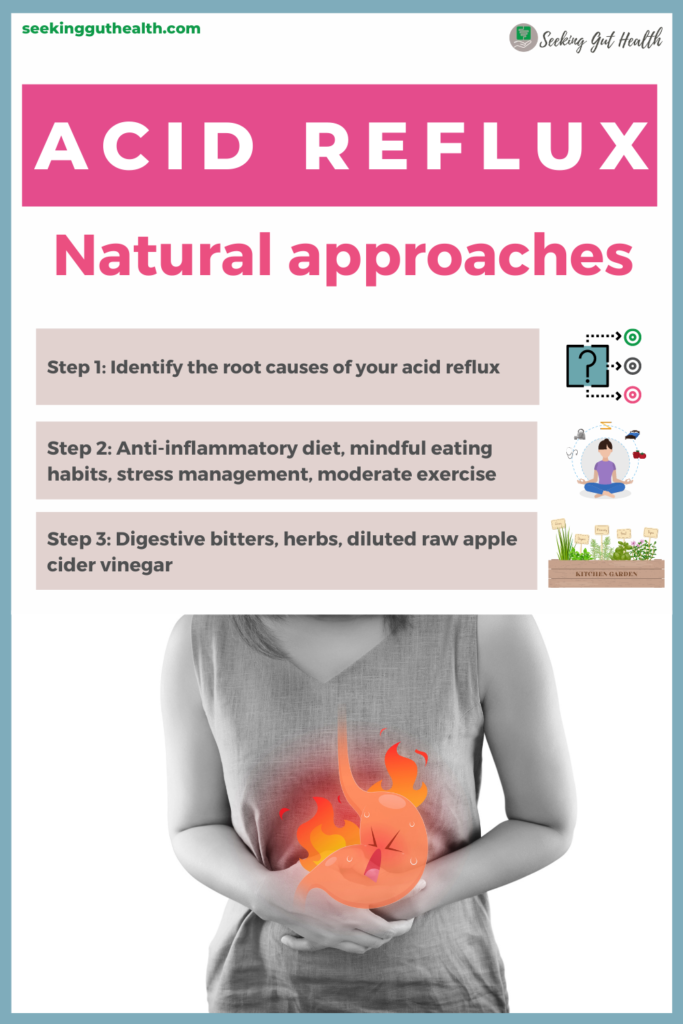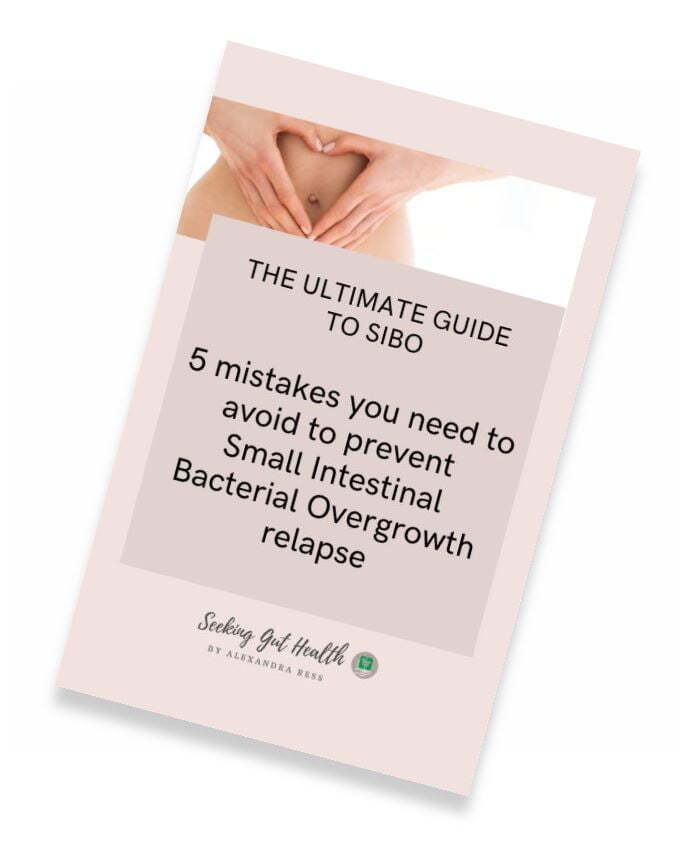Are you experiencing symptoms of GERD (Gastroesophageal Reflux Disease) such as heartburn? Many people experience heartburn from time to time, but when it becomes persistent, meaning it happens multiple times a week, then you may have GERD.
GERD is pretty common; according to a study, up to 30% of adults in the Western population are affected by GERD. (1)
What is GERD?
Gastroesophageal reflux (GER) happens when your stomach content flows back into your esophagus. This refluxed acid can irritate the lining of your esophagus. Gastroesophageal reflux disease (GERD) is a more severe and long-term disease in which GER creates recurring symptoms and may lead to other health consequences over time. (2)

GERD Symptoms:
- Heartburn (is a feeling of burning sensation in the chest area that usually gets worse at night)
- Chest pain
- Belching
- Regurgitation of food or liquid
- Regular throat clearing or coughing
- Excess mucus formation, post-nasal drip
- A sensation of a lump or "stuck" in your throat
- Hoarse voice
- Swallowing problems
- It can also lead to disrupted sleep. (3)
There are valves on the top and bottom of the stomach. A circular band of muscle on the top of the stomach (the lower esophageal sphincter(LES)) typically prevents stomach acid and content from flowing up into the esophagus. When you swallow, this sphincter relaxes and allows food and liquid to enter your stomach, and then it closes again.
The problem starts when the sphincter functions abnormally or weakens, allowing the stomach content and acid to flow back up into your esophagus and causing irritation.
The lower valve of the stomach allows the content to move into the small intestines and prevents food from flowing back up into the stomach. (4)
What causes GERD?
Stress
The autonomic nervous system controls the sphincters' function. When you are stressed, the sympathetic side of the autonomic nervous system gets activated, which is known as the fight-fright-freeze mode. (5) This state can lead to a dysfunctional sphincter. But there are other problems with stress that influence the whole digestive process.
When you are going through a stressful period, the blood will be pumped mainly to the muscles and other vital organs (away from the gut) to prepare the body to face the danger or run away from it. Digestion (immune function, reproduction, and many other bodily functions) is not essential in survival—the production of all digestive juices like stomach acid, pancreatic enzymes, bile flow decrease during stress.
Adequate stomach acid (HCl) is also required for proper sphincter function to stay closed and open only when needed. The sphincters have receptors that can detect hydrochloric acid (HCL). When stomach acid gets low, it can interfere with the signaling process to the sphincter, allowing it to be open longer or partially so that little acid and even remaining food content can come up to the esophagus causing all the uncomfortable symptoms.
Furthermore, less protective mucus is produced during stress, allowing stomach acid to cause damage to the gut's lining, leading to inflammation, even ulcers, and gastritis. (6)
Low stomach acid
So in the previous section, you could discover how stress can lead to low stomach acid, but let's analyze it a bit further.
The digesting fluid secreted in the stomach is gastric acid (stomach acid), colorless, watery, and super acidic. It is one of the most crucial digestive juice secreted with numerous enzymes and intrinsic factors. It has (typically) a pH of 1 to 2. The higher the number goes, the more alkaline it becomes, which we don't want because an adequate level of acid is required for:
- Protein digestion
- Activating pepsin (enzyme)
- Proper sphincter function (so the valve stays close and food doesn't reflux back)
- Stimulating other digestive juices to be released further down your digestive tract
- Mineral absorption
- Killing unwanted bacteria, parasites in the food (preventing SIBO or food poisoning)
- Activating intrinsic factor that is needed for vitamin B12 absorption (7)
The reality is that contrary to popular belief, heartburn symptom is mainly caused by low stomach acid and not high stomach acid.
Another factor that can cause lower stomach acid is Helicobacter pylori infection. This gram-negative bacteria can cause low-grade inflammation and damage to the stomach lining leading to ulcers, and it was even associated with gastric cancer. (8) Read more about Helicobacter pylori infection.
Stomach acid can be caused by chronic inflammation, autoimmune disorders, age (acid levels decrease as we get older). (9)
What is the issue with stomach acid lowering drugs?
Proton pump inhibitors (PPIs), antacids, and other drugs are commonly prescribed or purchased medications used to lower stomach acid. While there are cases when they might be needed short-term, long-term usage has a negative impact on the whole digestive process and body functions.
Long-term usage has been associated with Clostridium difficile infection, vitamin B12 deficiency, decreased magnesium levels, elevated risk of bone fractures, kidney diseases, dementia, SIBO (Small Intestinal Bacterial Overgrowth). (10)
These medications may mask the symptoms but won't resolve the underlying causes and predispose the individual to other health complications.
How can you improve stomach acid production?
Bitters are excellent to stimulate digestion. Bitter greens (kale, arugula, dandelion) or even digestive bitters (gentian) could be helpful.
Using diluted raw apple cider vinegar before meals can also help with digestion. Avoid if you have gastritis or histamine intolerance, and never use it undiluted because it can damage your teeth.
My favorite tip is eating slowly and chewing your food well. Digestion starts in the brain (yes! By looking at, smelling it, the brain gets the information that foods are coming in, so let's prepare for digestion!), but by chewing, you allow the enzymes in your saliva to start breaking down the food.
SIBO (Small Intestinal Bacterial Overgrowth)
SIBO stands for Small Intestinal Bacterial Overgrowth. It means an increase in the number of bacteria and/or changes in the types of bacteria present in the small intestine. SIBO is commonly caused by an overgrowth of various bacteria that should generally be found in the large intestine. (11)
SIBO can cause classic symptoms similar to IBS (Irritable Bowel Syndrome). These include abdominal pain, discomfort, cramping, gas, bloating, reflux, diarrhea, and/or constipation. According to studies, 84 % of IBS cases are caused by SIBO. (12) Read more about SIBO types.
One theory that Norman Robillard, Ph.D., suggested about SIBO causing GERD is that one of the leading symptoms of SIBO is usually bloating, and bacteria produce gas through carbohydrate (fiber) fermentation which can increase abdominal pressure pushing acid up to the esophagus. (13)
The other link I briefly mentioned above is that many people were given Proton Pump Inhibitors (PPIs) or antacids to manage their heartburn symptoms. Since adequate stomach acid is required to prevent overgrowth, treatment with acid blockers, especially long-term usage (over 1 year), may lead to SIBO. (14)
Imagine taking back control of your body and living bloat-free. Download your free guide and learn the 5 MISTAKES you need to AVOID TO PREVENT SMALL INTESTINAL BACTERIAL OVERGROWTH RELAPSE.
Grab your copy today!
Other contributing factors of GERD:
- Dysbiosis in the colon (15)
- Smoking (16)
- Obesity (16)
- Sedentary lifestyle
- Alcohol consumption (17)
- Bad eating habits (eating too fast, overeating, drinking during meal times)
- Certain foods
- Lying down immediately after eating
- Hiatal hernia (18)
- Pregnancy
- Certain medications
- Delayed stomach emptying (gastroparesis) (19)

Natural approaches to GERD
Many factors influence the prevalence of GERD.
The main focus should be on identifying and addressing the root causes of your GERD.
One of the first lines of approaches to GERD is lifestyle changes and nutrition. These are the areas where you have control over.
Certain foods are associated with worsening GERD symptoms, such as chocolate, fatty foods, fizzy drinks, oily foods, citrus fruits, tomatoes, coffee, alcohol, fruit juices that may cause irritation. While these foods don't directly cause GERD, they may worsen the symptoms. (20) (21) Doing an elimination diet to find your triggering foods can be beneficial.
Your eating habits play a more critical role than the food you eat. Controlling how you eat during your meal can make a difference by slowing down and chewing your food properly. Avoiding drinking during mealtimes can help the digestive process. Finding the optimal meal schedule is also crucial. Sometimes smaller meals may work better than consuming a huge portion of food all at once.
Gravity matters in controlling food movement; therefore, it is essential to avoid lying down after eating. It is better to go for a short walk that can even help with digestion. In many cases, heartburn symptoms happen at night; consider elevating the head of the bed. Planning meal times earlier and avoiding late snacks can also prevent sleep issues at night.
Since stress is one of the leading causes of GERD, stress management techniques are fundamental to switch back to the Parasympathetic side of the nervous system (the rest-and-digest response), so the blood can flow to the gut and ensure proper production of digestive juices.
The Bottom Line
GERD can manifest differently from person to person. If you suffer from chronic heartburn symptoms, finding the root causes and contributing factors is essential. Still, you can control the symptoms significantly by adjusting your diet, eating habits, and lifestyle. It is vital to be aware of the risks of long-term PPIs or antacids usage that may cause undesirable health conditions. They were intended to be used short-term.
This post is only for informational purposes and is not meant to diagnose, treat or cure any disease. I recommend always consulting with your healthcare practitioner before trying any treatment or dietary changes.
Ness-Jensen, E., Hveem, K., El-Serag, H., & Lagergren, J. (2016). Lifestyle Intervention in Gastroesophageal Reflux Disease. Clinical gastroenterology and hepatology: the official clinical practice journal of the American Gastroenterological Association, 14(2), 175–82.e823. https://doi.org/10.1016/j.cgh.2015.04.176
Acid Reflux (GER & GERD) in Adults". National Institute of Diabetes and Digestive and Kidney Diseases (NIDDK), https://www.niddk.nih.gov/health-information/digestive-diseases/acid-reflux-ger-gerd-adults
"Gastroesophageal reflux disease (GERD)". Mayo Foundation for Medical Education and Research. 1998-2022. https://www.mayoclinic.org/diseases-conditions/gerd/symptoms-causes/syc-20361940?p=1
Antunes C, Aleem A, Curtis SA. Gastroesophageal Reflux Disease. [Updated 2021 Jul 18]. In: StatPearls [Internet]. Treasure Island (FL): StatPearls Publishing; 2022 Jan-. Available from: https://www.ncbi.nlm.nih.gov/books/NBK441938/
Hornby, P. J., & Abrahams, T. P. (2000). Central control of lower esophageal sphincter relaxation. The American journal of medicine, 108 Suppl 4a, 90S–98S. https://doi.org/10.1016/s0002-9343(99)00345-9
Inhibition of gastric acid secretion by stress: A protective reflex mediated by cerebral nitric oxide J. V. Esplugues, M. D. Barrachina, B. Beltrán, S. Calatayud, B. J. R. Whittle, S. Moncada Proceedings of the National Academy of Sciences Dec 1996, 93 (25) 14839-14844; DOI: 10.1073/pnas.93.25.14839, https://doi.org/10.1073/pnas.93.25.14839
JAMES L. SMITH; The Role of Gastric Acid in Preventing Foodborne Disease and How Bacteria Overcome Acid Conditions. J Food Prot 1 July 2003; 66 (7): 1292–1303. doi: https://doi.org/10.4315/0362-028X-66.7.1292
Wu, M. L., & Lewin, K. J. (2001). Understanding Helicobacter pylori. Human pathology, 32(3), 247–249. https://doi.org/10.1053/hupa.2001.22898
Britton, E., & McLaughlin, J. (2013). Ageing and the gut. Proceedings of the Nutrition Society, 72(1), 173-177. doi:10.1017/S0029665112002807 https://doi.org/10.1017/S0029665112002807
Avinash K. Nehra, Jeffrey A. Alexander, Conor G. Loftus,Vandana Nehra, Proton Pump Inhibitors: Review of Emerging Concerns. Concise review for clinicians| volume 93. issue 2. p240-246. february 01, 2018. DOI: https://doi.org/10.1016/j.mayocp.2017.10.022
. Bures, J., Cyrany, J., Kohoutova, D., Förstl, M., Rejchrt, S., Kvetina, J., Vorisek, V., & Kopacova, M. (2010). Small intestinal bacterial overgrowth syndrome. World journal of gastroenterology, 16(24), 2978–2990. https://doi.org/10.3748/wjg.v16.i24.2978
Reddymasu, S.C., Sostarich, S. & McCallum, R.W. Small intestinal bacterial overgrowth in irritable bowel syndrome: are there any predictors?. BMC Gastroenterol 10, 23 (2010). doi.org/10.1186/1471-230X-10-23
Kim, K. M., Kim, B. T., Lee, D. J., Park, S. B., Joo, N. S., Kim, Y. S., & Kim, K. N. (2012). Erosive esophagitis may be related to small intestinal bacterial overgrowth. Scandinavian journal of gastroenterology, 47(5), 493–498. https://doi.org/10.3109/00365521.2012.668932
Lombardo, L., Foti, M., Ruggia, O., & Chiecchio, A. (2010). Increased incidence of small intestinal bacterial overgrowth during proton pump inhibitor therapy. Clinical gastroenterology and hepatology : the official clinical practice journal of the American Gastroenterological Association, 8(6), 504–508. https://doi.org/10.1016/j.cgh.2009.12.022
Haworth, J. J., Boyle, N., Vales, A., & Hobson, A. R. (2021). The prevalence of intestinal dysbiosis in patients referred for antireflux surgery. Surgical endoscopy, 35(12), 7112–7119. https://doi.org/10.1007/s00464-020-08229-5
Smith, K. J., O'Brien, S. M., Smithers, B. M., Gotley, D. C., Webb, P. M., Green, A. C., & Whiteman, D. C. (2005). Interactions among smoking, obesity, and symptoms of acid reflux in Barrett's esophagus. Cancer epidemiology, biomarkers & prevention : a publication of the American Association for Cancer Research, cosponsored by the American Society of Preventive Oncology, 14(11 Pt 1), 2481–2486. https://doi.org/10.1158/1055-9965.EPI-05-0370
Pan, J., Cen, L., Chen, W., Yu, C., Li, Y., & Shen, Z. (2019). Alcohol Consumption and the Risk of Gastroesophageal Reflux Disease: A Systematic Review and Meta-analysis. Alcohol and alcoholism (Oxford, Oxfordshire), 54(1), 62–69. https://doi.org/10.1093/alcalc/agy063
Smith, R. E., & Shahjehan, R. D. (2021). Hiatal Hernia. In StatPearls. StatPearls Publishing.
Noar, M. D., & Noar, E. (2008). Gastroparesis associated with gastroesophageal reflux disease and corresponding reflux symptoms may be corrected by radiofrequency ablation of the cardia and esophagogastric junction. Surgical endoscopy, 22(11), 2440–2444. https://doi.org/10.1007/s00464-008-9873-4
Dağlı, Ü., & Kalkan, İ. H. (2017). The role of lifestyle changes in gastroesophageal reflux diseases treatment. The Turkish journal of gastroenterology : the official journal of Turkish Society of Gastroenterology, 28(Suppl 1), S33–S37. https://doi.org/10.5152/tjg.2017.10
Surdea-Blaga, T., Negrutiu, D. E., Palage, M., & Dumitrascu, D. L. (2019). Food and Gastroesophageal Reflux Disease. Current medicinal chemistry, 26(19), 3497–3511. https://doi.org/10.2174/0929867324666170515123807
Related posts:

Alexandra is a Functional Medicine Certified Health Coach & Holistic Nutritionist specializing in IBS, SIBO, and Gut Health. She helps her clients identify the root causes of their chronic gut issues with functional testing, supporting their bodies holistically and implementing the necessary lifestyle changes long-term to regain control of their bodies and enjoy food freedom. Book your FREE SIBO Assessment call now >>>

